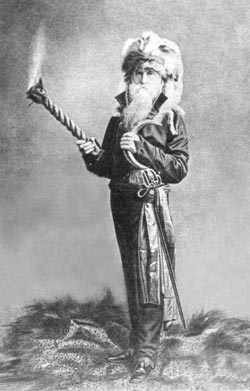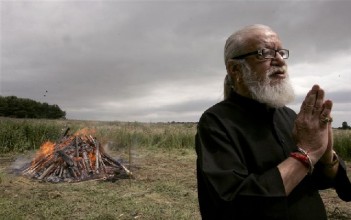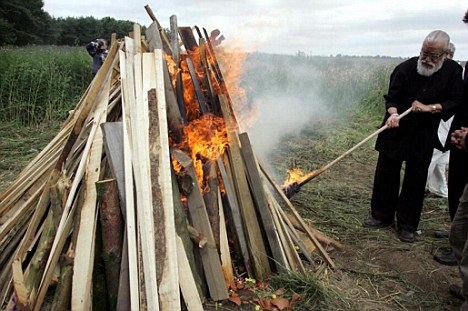History & Politics
In 1883 when Welshman Dr William Price (above) healer, druid and naturist, fathered a child withhis housekeeper, nearly sixty years his junior, nobody was surprised. He had alreadyformed a reputation as a flamboyant eccentric, endorsing free love and vegetarinisim andrefusing to treat those who smoked.

Often seen stalking the hillsides naked in his youth, bythe time his son – defiantly named Iesu Grist (Jesus Christ) – was born to him in his eighties, he hadtaken to wearing a scarlet waistcoat and fox-skin headpiece and parading through towncarrying a blazing torch and druidical crescent moon.
It was the death of the aforementioned son when he was barely one year oldthat was to seal the doctor ºs place in history. A heartbroken Dr Price took the boy ºs body toa hilltop, on a Sunday and in full view of the nearby chapel, and attempted to cremate himin paraffin.
A furious crowd dragged the body from the flames, calling it a ‚”vicious act of blasphemy‚” andrioted, nearly killing the doctor in the process. His eloquent and theatrical defence andsubsequent acquittal captured the imagination of the nation and paved the way for thelegalisation of cremation through the Cremation Act of 1902.
A grateful, though nervousWoking crematorium finally fired up its burners, installed but never lit due to the ambiguityof the law, and the age of burning our dead began. The Doctor ºs own subsequent triumphant hilltopimmolation was witnessed by a crowd of twenty thousand and celebrated in song, storyand on some very collectable postcards.
Open air pyres

Fast forward a hundred and twenty odd years and Mr Davender Ghai, a British Hindu andfounder of The Anglo-Asian Friendship Society returned to our courts seeking solidaritywith Dr Price and the relegalisation of the right to be cremated in Britain in accordance with hisreligious custom, on an open air pyre.
In February 2010, Mr Ghai won his battle at the Court of Appeal, which ruled that he had a right to be cremated in accordance with his beliefs. Mr Ghai ºs legal challenge was on religious grounds, and we are proud to stand beside him representing everyone who would choose a natural cremation, whatever their personal beliefs.
Throughout the nearly two decades during we have operated afuneral helpline to the public, we have fielded calls, sometimes at the rate of one a week,asking whether this is legal and possible.
We have always felt it should be onenvironmental, social and spiritual grounds and in the past we have stated that an open aircremation fits our idea of the perfect funeral ceremony.

Natural Cremation, Fuel and the Environment
For thousands of years, sustainable fuel was sourced from managed woodland. The very word ‚Äòwood‚’ differentiates this product from timber; wood being small poles and rods used in the production of hurdles for example and fuel wood, which is burnt in its raw state or processed into charcoal. Timber being the taller standard trees grown for building materials, shipping and furniture. So for millennia, our ancestors knew how to maximise the production of this renewable carbon neutral resource.
The combination of the Second World War and our modern reliance on fossil fuels has sadly resulted in the majority of British woodland being unused and its management being financially unviable, so a huge percentage of it is currently in a dilapidated and worthless state, used in many cases solely by hunts and shoots.
Walk into most broadleaf woodland today and you will be surrounded by dead and dying trees and rotting coppice stools. This might be great for fungi but our other woodland fauna and flora, which have developed to live within our managed woodlands or which have survived from the ancient ‚Äòwild wood‚’ for thousands of years, are losing a foothold, as the habitat they evolved to occupy becomes rarer.
The wood needed for funeral pyres could provide an answer to some of this neglect. Coppiced hazel under Oak, which is a very common planting mix in many woods throughout the UK, could supply a clean, fast and hot burning energy source. This would include all not so straight ‚Äòseconds‚’ that have no resale value or use in hurdle making for example. The money paid for this fuel could provide the financial input necessary to rescue some of our heritage woodland and as a consequence many types of wildlife.
One problem faced by natural cremation is the issue of mercury emissions. When teeth containing amalgam fillings are burnt, mercury vapour is released. Attempts are made to deal with this at conventional gas cremators with filters in the chimneys, however these are not 100% effective and as a consequence 19% of airborne mercury is attributed to crematoria. Even with better filtration, this level is set to rise as the number of people dying with their own teeth intact increases. The only answer to the problem of no filtration posed by pyres is to remove either the fillings or the teeth containing them. If this is the only problem faced by the dying or bereaved who wish to have this type of cremation, it is a small price to pay.
Thanks to theNatural Death Centre

